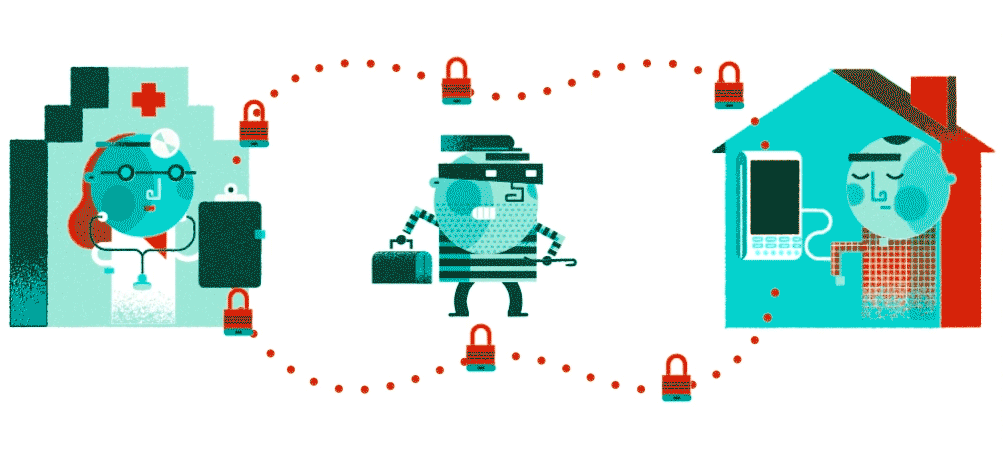質問:
在宅医療において、患者のデータを暗号化するだけでセキュアな接続を保証することは可能なのでしょうか?

回答:
暗号化は、セキュリティを確保するための1つのレイヤに過ぎません。認証、完全性の検証、ファームウェアのセキュアなアップデートなども同様に重要です。患者のデータ、アップデート用のデータ(新たなコードや新たな設定用のデータなど)の発信元や完全性が検証されていない場合、暗号化を実施するだけでは、無意味なデータや悪意のあるデータがやり取りされるのを防ぐことはできません。セキュアな接続(ネットワークによる接続)を実現するには、誰が何を送信しているのかを確認し、情報が改ざんされていないことを保証する必要があります。
はじめに
アナログ・デバイセズは、「Secure Authentication for Medical Disposables(使い捨て型の医療用器具に最適なセキュア認証)」という記事を公開しています。この記事は、使い捨て型の医療用器具に適用されるセキュア認証の基本について説明したものです。その内容を踏まえて、本稿では医療分野で見られる1つの動向に注目することにします。その動向とは、医療の場を病院から患者の自宅へ移行させるというものです(図1)。本稿では、医療施設の外部で医療を提供する際に生じるセキュリティ上の課題について詳しく説明します。特に、ネットワークを介してデータを伝送する際、それらのデータを保護するために必要となる要件に着目します。その上で、それらの要件を満たすためのソリューションを紹介します。
在宅医療に関するトレンド
ここでは、在宅医療に関連する重要なトレンドについて説明します。
患者に対する指導を伴うセルフケアへの移行が拡大
技術革新の後押しを得て、多くの患者は快適な自宅で自身の健康状態を管理できるようになりました。実際、医療分野では患者に対する指導を伴うセルフケアへの移行が加速しています。そのためには、ウェアラブル機器や、ヘルスケア用のモバイル・アプリ、リモート医療用のプラットフォームといった高度なツールが必要になります。それらを活用し、健康に関するリアルタイムのデータをやり取りしたり、専門家からの指導を受けられるようにしたりするということです。その結果、患者が自身の状態をモニタリングしたり、医師が治療に関する情報に基づいた判断を下したりすることが可能になります。そうしたセルフケアへの移行が実現されれば、利便性が高まります。それだけでなく、持続的な医療の適用が促進されるようになります。指導を伴うセルフケアに移行すれば、患者は自身の自主性と生活の質を維持することが可能になります。また、長期的な健康管理のサポートが得られるようになると共に、医療へのアクセス手段が拡大します。更に、医療施設の負担も軽減されます。
規制と品質に関する懸念の高まり
在宅医療の拡大が続くなか、FDA(Food and Drug Administration)などの規制機関は、家庭の環境で使用される医療用機器(以下、「機器」という用語は、在宅医療に用いる医療用機器のことを指します)の安全性と有効性を確保するために、より厳格なガイドラインを導入しています。その例としては、FDA-2021-D-1158、FD&C法のセクション524B、議会法HR2617、UL2900-2-1、IEC 62443といったものが挙げられます。これらの規制は、患者の保護、高水準の医療の維持のために不可欠なものです。新規の機器を開発したり既存の機器に変更を加えたりする場合には、潜在的な脆弱性に対処し、医療関連の機密性の高いデータを保護するために、サイバーセキュリティに関する詳細な計画を策定する必要があります。そうした規制を遵守し、品質保証に対する重点的な取り組みを強化することにより、在宅医療用のソリューションに対する信頼が生まれます。このことは、患者が安全性に優れ、信頼性が高く、効果的な治療を受けられるようにするために不可欠です。
在宅医療の一般的なワークフロー
ここでは、在宅医療に関する基本的な事柄について整理します。そのワークフローは、一般的には図2に示すようなものになります。
以下、図2の各番号に対応する内容の詳細について説明します。
- 最初の診察と機器のプログラミング:多くの場合、在宅医療のプロセスは病院/クリニックで行われる初診から始まります。その際、医師は患者と面談して包括的な診察を行います。この初診の際に、医師は患者の状態を診察し、適切な治療計画を決定します。医師は、各患者に固有のニーズに応じて医療用機器の設定をプログラムします。設定が完了したら、自宅で機器を効果的に使用できるよう患者に対して詳細な指示を行います。
- 在宅治療の開始:帰宅した患者は、医師の指示に従い、処方どおりに機器を使用して治療を開始します。この期間は、患者が機器の扱いに慣れ、必要な一連の作業を日課に組み入れる上で非常に重要です。リマインダ、アラート、使いやすいインターフェースといった機能は、患者が治療計画を遵守し、患者の自主性を後押しし、治療の効果を高めることに役立ちます。
- 患者のデータのアップロード:在宅医療において重要なのは、患者の状態を継続的にモニタリングし、その結果となるデータを適切に送信することです。患者のデータには、バイタル・サイン、服薬アドヒアランス(服薬の遵守)、健康に関連するその他の指標の値が含まれます。例えば、患者が就寝中に機器を充電器に接続しておくと、毎日の活動をトラッキングしたデータが自動的にローカルのネットワークにアップロードされるという使い方が考えられます。また、特定の事象が発生したとき(ユーザに関する問題や有害な事象が検出されたときなど)だけ機器からデータが送信されるという方法もあり得ます。あるいは、患者がモバイル・アプリケーションに手作業で値を入力したらデータが送信されるようにすることも可能です。シームレスに情報を伝送することにより、医師は最新のデータにアクセスできるようになります。その結果、必要に応じてタイムリーな介入や治療計画の調整を行うことが可能になります。
- 医師によるデータの確認:一定の期間が経過したら、医師は機器が収集したデータを確認します。それにより、医師は包括的な分析を行い、患者の経過を評価し、治療計画の変更が必要か否かを判断します。医師による評価は、機器が提供する詳細なデータに基づいて行われます。この方法であれば、従来のように病院で定期的に診察を行うよりも、患者の健康状態を正確に把握できるようになります。このような積極的なアプローチにより、潜在的な問題を早期に特定することが可能になります。また、患者のニーズにより適切に対応するように治療計画を調整することができます。
- 医師によるアップデート用データの送信:医師が調整が必要だと判断した場合には、機器の設定をリモートでアップデートすることができます。治療に関連するアップデートの内容としては、圧力センサーのゲインのような主要なパラメータの調整、薬物を投与する頻度の変更、治療の内容の変更などが挙げられます。通常のアップデートは、ファームウェアの新バージョンを適用するという形で行われます。そのためには、患者の自宅にある機器にアップデート用のデータをセキュアにアップロードする必要があります。これを実現すれば、患者が最新かつ効果的な治療を受けられることが保証されます。リモートで機能を調整できることは、現代の在宅医療システムならではの大きな長所です。頻繁に通院する必要がなくなると共に、より柔軟性が高く迅速な治療を実施することが可能になります。
- 機器によるファームウェアのアップデート:医師がファームウェアのアップデート用データを送信したら、機器はネットワークに接続してデータを受信し、インストールを実行します。通常、このプロセスは自動化されるので、患者が介入する必要性は最小限に抑えられます。このアップデートにより、機器が最新の設定とセキュリティ用のプロトコルをベースとして動作することが保証されます。アップデートが完了したら、患者は継続的な治療の一環として機器を使用し続けることになります。データの収集、確認、調整というサイクルが繰り返し実施されることにより、患者のニーズの変化に適応可能な動的で対応力に優れた医療環境が構築されます。
在宅医療におけるセキュリティ上の課題
患者のデータと機器のセキュリティを確保するためには、重大な課題を解消しなければなりません。上述したような形で在宅医療を実施するためには、デジタル・プラットフォームや接続用の機器が必要になります。その結果、健康に関する機密性の高い情報が漏洩したり、不正アクセスなどの潜在的な脅威にさらされたりする可能性が生じるのです。患者からの信頼の獲得、医療分野の規制への確実な準拠、在宅医療サービスの完全性の保護を実現するためには、そうしたセキュリティ上の課題に対処することが不可欠です。ここで図3をご覧ください。これは、一般的な在宅医療のワークフローの各段階に特有のセキュリティ上の課題についてまとめたものです。
上記の課題を踏まえた場合、どのような変化が求められるのでしょうか。以下、それについて説明します。
- 最初の診察と機器のプログラミング:初診時および在宅治療の開始時に、いくつかのセキュリティ上の懸念事項に対処する必要があります。重要な要素の1つはセキュア・ブートです。つまり、機器が起動した際に、信頼できるソフトウェアだけが実行されることを保証する必要があります。そうすれば、機器の機能や患者の安全性に害をもたらす悪意のあるソフトウェアがロードされるのを防止できます。また、不正なアクセスや改ざんからの保護を実現するためには、セキュアなデータ・ストレージが不可欠です。そのストレージは、機器に保存されるデータに暗号化を施したり、権限のある人だけが機器の設定を変更できるようにしたりするための堅牢性の高いアクセス制御機能を備えていなければなりません。加えて、ファームウェアのパラメータの完全性が保証されている必要があります。例えば、患者の安全を守るためには、10mL/時という投与量の設定が誤って100mL/時に変更されないようにすることが必須です。ファームウェアの真正性と完全性を検証するためには、暗号化されたデータに対するチェックサム機能とデジタル署名を利用することになるでしょう。
- 患者のデータのアップロードと伝送:患者のデータを機器から医師に対してアップロードする際には、伝送中のデータを保護するためにセキュリティ上の複数の対策を施す必要があります。最も優先すべきことは真正性の確保です。つまり、医師が受信したデータが対象とする患者から送信されたものであることを保証しなければなりません。これを実現するためには、各患者に固有の識別子とセキュアな認証プロトコルが必要になるでしょう。また、完全性を確保することも非常に重要です。つまり、データが伝送中に改ざんされていないことを保証しなければなりません。データが変更されていないことを確認するためには、ハッシュ法やデジタル署名などの手法が有効です。医師が患者の状態を評価し、それに応じて治療計画を調整するためには、正確かつ信頼性の高いデータが必要になります。例えば、データが破損していたりすると誤った評価が行われてしまうかもしれません。患者の血圧が危険なほど高いのにもかかわらず、破損したデータが原因で血圧が安定しているという誤った判断が下されるといった具合です。加えて、患者の情報の伝送中にそのデータを保護する上では機密性の確保が非常に重要になります。つまり、不正なアクセスからデータを保護し、伝送中にも機密性が維持されることを保証しなければなりません。そのためには、伝送するデータを暗号化するTLS(Transport LayerSecurity)やVPN(Virtual Private Network)などのセキュアな通信プロトコルを使用する必要があります。更に、厳格なアクセス制御機能と認証メカニズムを実装することにより、認証された人だけが患者の情報にアクセスできるようになります。
- ファームウェアのアップデート:医師が機器にアップデート用のデータを送信する場合、アップデートのプロセスの安全性を確保することが不可欠です。不正なアクセスや不正なアップデートが可能である場合、侵入者が機器の動作を変更してしまうおそれがあります。最悪の場合、機器の制御が完全に奪われてしまうかもしれません。一般的な攻撃方法の1つにマルウェアを使用するというものがあります。この方法が使われると、悪意のあるコードがファームウェアのアップデート用データに挿入されてしまいます。攻撃者が不正なファームウェアのインストールに成功した場合、深刻な結果を招いてしまうかもしれません。例えば、健康状態をモニタリングする可搬型の機器が侵害された場合、個人の医療情報をはじめとする機密性の高いデータが無断で送信されてしまう可能性があります。また、より広い視野で見ると、悪意のあるファームウェアによって暗号鍵が公開され、システム全体のセキュリティが揺るがされてしまうかもしれません。加えて、機器が誤動作する状態に陥り、患者の安全とデータの完全性の面で重大なリスクが生じるおそれもあります。したがって、新たなファームウェアの真正性を検証し、それが信頼できる発信元から送信されたものであることを確認しなければなりません。その確認は、ファームウェアの発信元を認証するデジタル署名とデジタル証明書によって実現できます。病院で最初に機器が設定される場合と同様に、ファームウェアのアップデートの完全性は、すべてのパラメータの値が改ざんされていないことを保証する上で非常に重要です。暗号化されたデータに対するチェックサムと完全性のチェック手法を使用すれば、ファームウェアの完全性を検証できます。機密性の高いデータを保護するためには、ファームウェアのアップデート用データを伝送している間の機密性を維持しなければなりません。ファームウェアのアップデート用データに暗号化を施すことにより、第三者による不正な傍受/アクセスを防止することが可能になります。
暗号化機能を備えるICにより、セキュリティ上の課題に対処する
「MAXQ1065」はセキュリティを確保するために使用されるコプロセッサであり、ターンキーの暗号化機能を提供します。これを使用すれば、信頼の基点(Root-of-Trust)、相互認証、データの機密性と完全性の確保、セキュア・ブート、ファームウェアのセキュアなアップデート、セキュアな通信を実現できます(図4)。表1はMAXQ1065の主な機能についてまとめたものです。
表1. MAXQ1065の機能
| 機能 | 説明 |
| ハードウェア・ベースの暗号化 | SHA-256とHMACハッシュ、AES-128/256(GCM、CBC、ECB、CCM)、ECC(NIST P-256)とECDSAによる相互認証 |
| ChipDNA PUF技術 | 暗号鍵と機密データに対する究極の保護機能を提供。レジスタ/メモリ内に暗号鍵が静的に存在することがないようにしつつ、ICの電気的境界の外に流出することがないようにすることで、鍵のセキュアな保護を実現 |
| セキュアな通信 | TLS/DTLS 1.2のプロトコルにより、セキュアなデータ伝送をサポート。TLSハンドシェイクとレコード層。X.509証明書の保存/管理 |
| セキュア・ストレージ | ユーザ・データ、暗号鍵、証明書、カウンタ用の8kバイトのセキュア・ストレージ |
| 改ざんの検出 | 物理的な改ざんの試みの識別/対処 |
| 通信用インターフェース | SPI/I2C |
| 低消費電力 | 在宅医療用の機器は バッテリ駆動であることが多い。そのため、エネルギー効率が重要になる。MAXQ1065は 超低消費電力なので、頻繁にバッテリを交換することなく機器を長期間にわたって動作させられる。このことは、健康状態をモニタリングするためのウェアラブル機器や可搬型の医療用機器にとって特に有用 |
セキュア・ブート、ファームウェアのセキュアなアップデート
非対称暗号をベースとすれば、ファームウェアのセキュアなダウンロードを実現できます。その基本原理としては、ファームウェアの開発者による署名用の秘密鍵、医療用機器に保存されている検証用の公開鍵を使用します。特に、楕円曲線デジタル署名アルゴリズム(ECDSA:Elliptic Curve Digital Signature Algorithm)を使用する場合、攻撃者が高度な侵入型の攻撃を行ってもファームウェアとデータの署名に使用された秘密鍵を取得できないことが保証されます。攻撃者が機器から取得できる唯一の情報は公開鍵です。ECDSAを使用する場合、公開鍵から秘密鍵を導出することは数学的には不可能です。
ファームウェアを医療用機器のマイクロコントローラ(MCU)で実行する必要があるケースを考えます。その場合、ホストとなるMCUのブート・マネージャは、まずファームウェアを取得し、SHA-256でハッシュを算出するためにMAXQ1065に引き渡します(図5)。SHA-256のハッシュの計算が完了すると、プロセッサはファームウェアまたはデータのECDSA署名を提供します。この署名は開発段階で計算され、ファイルに付加されます。次に、メインのプロセッサはファームウェアまたはデータ・ファイルに加え、期待されるデジタル署名を送信します。続いて、セキュリティ対応のコプロセッサが署名を検証します。同コプロセッサは、検証に成功したか否かを表す結果を返します。署名の検証に成功すると、ファームウェアを実行することが可能になります。
このプロセスの詳細については、「The Fundamentals of Secure Boot and Secure Download: How to Protect Firmware and Data Within Embedded Devices(セキュア・ブートとセキュア・ダウンロードの基礎 - 組み込み機器内のファームウェアとデータを保護する方法)」をご覧ください。
セキュア・ストレージ、改ざんの検出
MAXQ1065は改ざんを検出する機能を備えています。その機能により、物理的な改ざんの試みを識別して対処を図ることができます。その結果、セキュリティが一層強化され、侵入の可能性があるケースでも機器の信頼性が維持されます。アナログ・デバイセズは、組み込み向けのセキュリティ技術「ChipDNA®」を提供しています。同技術の物理的複製防止機能(PUF:Physically Unclonable Function)を使用すれば、侵入型の攻撃やリバース・エンジニアリング型の攻撃に対する保護を飛躍的に強化することができます。ChipDNAの動作を調査/観察しようとすると、基盤となる回路の特性が変化します。そのため、チップの暗号化機能に使用されている固有の値が特定されることを防止できます。同様に、ChipDNAのPUF回路を動作させるためには、工場から出荷する際に調整が必要になります。そのため、より徹底したリバース・エンジニアリングの試みも阻止されます。デバイスごとに固有の鍵は、暗号化の処理に必要な場合だけChipDNAのPUF回路によって生成されます。そして、その鍵は使用後に即座に削除されます。
TLSによる保護
MAXQ1065は、セキュアなデータ伝送を実現するためのプロトコルとしてTLS/DTLS 1.2をサポートしています。それにより、データの機密性と完全性が確保されます。これは、患者のデータを医療従事者やクラウド・ベースのシステムに伝送する必要がある機器において不可欠なことです。
このシナリオにおいて、患者の自宅にある機器は、TLSを使用してクラウド・サーバとの間でセキュアな通信を実行します。TLSには、ハンドシェイク、セキュアな通信という2つのフェーズがあります。MAXQ1065のようなセキュアICは、認証局(CA:Certificate Authority)のルート証明書を不揮発性メモリに保存することによってTLSを強化しています。それにより、認証された管理者だけがそれらを交換することが可能になります。ハンドシェイクのフェーズでは、セキュリティに関する設定のネゴシエーションが行われ、共有鍵が確立されます。一方、セキュア通信のフェーズでは、それらの鍵が暗号化と認証に使用されます。組み込み機器にTLSの機能を実装するのは複雑な作業になる場合があります。そのことに起因して、証明書の検証が省略されたり、脆弱な暗号化用スイートが使用されたりするといったリスクが生じます。それに対し、MAXQ1065はハードウェア・ベースの保護機能を提供します。それらの機能により、不正なアクセスが防止され、TLSのプロセスの完全性が保証されます。結果として、中間者攻撃やセッション鍵の漏洩に対する防御が可能になります。つまり、機器の性能を損なうことなく、医療関連のデータの機密性と完全性を維持できるということです。
また、MAXQ1065を利用すれば、メーカーは接続される機器のために独自のCAを設置し、ルート公開鍵を安全に保管し、不正な改ざんを防止することが可能になります。ChipDNA技術では、ICを製造する際の通常の物理的な分布を利用した副生成物として秘密鍵を用意します。それにより、ハッキングやリバース・エンジニアリングに対する耐性が高まり安全性が向上します。
セキュア・コンパニオンICを使用してTLSの実装を保護する方法については、「セキュアコンパニオンICを使用したTLS実装の保護」を参照してください。
まとめ
在宅医療向けのソリューションに対する需要は高まり続けています。そうしたなか、セキュアで信頼性の高い医療用機器はますます重要なものになっています。アナログ・デバイセズは暗号化に対応するコントローラICとしてMAXQ1065を提供しています。同ICは、高度なセキュリティ機能、少ない消費電力、組み込みの容易さによってそうしたニーズに対応します。このコプロセッサを在宅医療用の機器に組み込むことで、患者のデータをセキュアな状態に維持しつつ、その機器を長期間にわたって確実に機能させることが可能になります。






